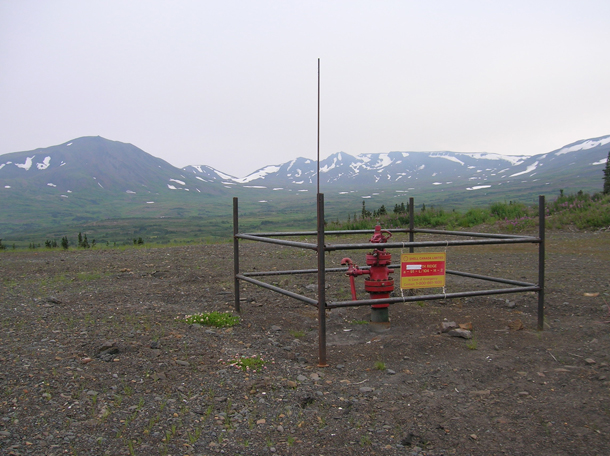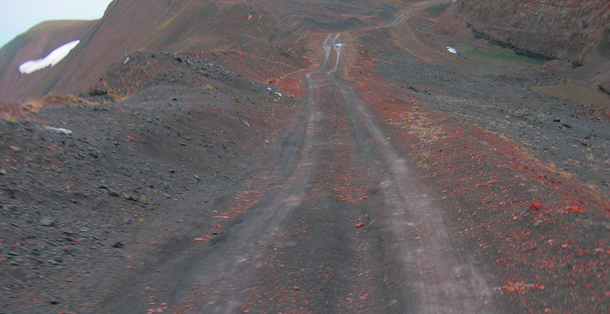[Read part one of this story here.]
The last time I saw Oscar Dennis, he was the newly crowned president of the Iskut Power Corporation, a wind power venture in the Klappan Valley that planned to tap into the power line. "By taking control of the energy, we control what happens on our territory, and that means building an economic base that is totally independent of INAC [Indian and Northern Affairs Canada] and industry," he told me. When I bump into him by chance at the Tatogga Lodge months later, in August of last year, Dennis is telling a different story.
We sit down for lunch and he says three suicides have occurred over the last year in the Tahltan Nation, and that he, one of Iskut's natural leaders, is packing it in and moving to the Lower Mainland.
His wind venture has fizzled, not that he confirms this. Later that week, at the last minute before a planned sit-down interview, he cancels.
Billions of dollars in potential profits are at stake as the government-subsidized Northwest Transmission Line power project opens up northwest British Columbia to a coming mining boom. But it's not clear yet exactly how the local First Nations will participate in the new economy, and how the culture and character of the place will be altered.
As this is being written, the Tahltan Central Council (TCC), a not-for-profit society created to negotiate with industry and government on behalf of the roughly 5,000 Tahltan, is negotiating an impact benefit agreement (IBA) for the northwest transmission line with BC Hydro, a project currently going through a streamlined B.C. environmental assessment (EA).
Such IBAs, sometimes referred to as benefit sharing or partnership agreements, are now standard practice in cases where resource projects are planned on unceded traditional native territories -- negotiated to spell out how benefits will accrue to the natives (e.g., jobs, revenue sharing), and to formalize the mitigation of social and environmental impacts.
Most recently, the TCC has signed agreements for the Forrest Kerr run-of-river hydro project, which now holds a 60-year energy purchase agreement with BC Hydro, and the currently stalled Galore Creek mine. In the latter case, the TCC negotiated to receive at least $1 million a year indexed to inflation, a tiny share of net concentrate sales after a certain point in the mine life, and another tiny chunk of net sales after a specified point. About $15,000 a year would have fed at scholarship supporting Tahltan students.
As for the power line, which will enable such projects to move forward, the environmental assessment (EA) process has proven complicated. The process was delayed in Sept. 2010, after federal agencies asked (among other things) how power line environmental impacts would interact with the separate footprints created by five specific resource projects expected to move forward.
Contained in this new study is a "conceptual best-case" scenario, which predicts that once the power line is operational in 2014, four of the proposed projects will be up and running by 2015. This is in addition to the most "reasonably foreseeable projects" of Forrest Kerr Hydro, Galore Creek and Red Chris.
Bruce Hill, a conservationist and co-founder of the Headwaters Initiative (which works with B.C. northern communities to build capacity around development and conservation issues), says such a future where multiple big mines operate concurrently -- producing mostly the same raw commodity -- is a lose-lose for everyone.
"The people that run mining companies, curiously enough, are often pretty shitty capitalists," said Hill over coffee in his Terrace kitchen in August. "The industry says, 'We need a 500 kilovolt power line because we could run a bunch of mines the size of Galore creek,' but if they had that up there, copper would be worth 50 cents a pound instead of over $3. That's the way markets work."
Concern over just this boom and bust scenario is the subject of separate government-to-government negotiations currently taking place between the Tahltan Central Council and the province. The TCC says it cannot support any benefits agreement with BC Hydro without a separate agreement with the province to address the longer-term impacts created by the power line.
"The [power line] is essentially the gateway to a completely transformed region over time," says Gary Merkel, the TCC's lead negotiator in an Oct. 2010 newsletter to the Tahltan nation. He adds that the negotiations -- which had to be "mostly finalized" by December -- will formalize how the Tahltan and provincial government manage the "pace and direction of development, the evolution of the Tahltan community and the Tahltan's participation in the economic benefits that will flow from this regional transformation."
"We can't support this type of project [the power line] if they are just going to come and rape and pillage our territory," says Rick McLean, Chief of the Telegraph Creek band, which has jurisdiction over the Tahltan communities of TC and Dease Lake. "With the current metal prices, and economic climate changing to positive again, it's a very real concern of ours that 11 projects may come on line and into production by 2016 or 2017. It's a huge concern, and that's why we're working hard at this government to government table to lessen the impacts and decide which projects come on line and which don't."
Art of the fair deal
Tony Pearse, who works as a consultant and advisor to B.C. First Nations around issues of resource development, has seen his share of resource agreements, and says there are certain core ingredients to a good deal for the Tahltan and other B.C. native communities.
It is very important, he says, that a provision be included that restates the company's obligations under existing environmental laws, because if the company does not follow the rules later, government regulators seldom prosecute. But if it's in the contract, it provides a "legal handle" for future enforcement if they need it.
To avoid the kinds of social issues that are already touching Iskut, Pearse says natives can negotiate specific provisions to dictate how outside workers are used for a project. He cites the example of a B.C. First Nation that negotiated a provision to ensure mine workers would be located at the mine site only. (Community monitoring programs with mitigation plans for social impacts from the mine are another tool that can be negotiated.)
"They didn't want 300 miners to be housed in their community because of the serious social and cultural impacts that would create," he says. "The company understood this problem and was willing to make the change."
On the benefits side, beyond the routine assurance of jobs, Pearse says First Nations must try to negotiate more than just a base level revenue stream from the mine -- they should also include a provision for sharing "windfall" profits. Windfall profits occur when there are unexpected commodity price jumps, where profits suddenly grow high above any original assumptions made about project viability. In such cases, Pearse says the natives should get a piece of the action.
"Why should all those windfall profits go to the company when it's on Indian land and arguably it's Indian resources as well?"
Touring the Wild West
Before I head back to Smithers for my flight home, I take a ride with Paul Colangelo into the Klappan valley, which happens to be the site of Shell's Klappan-Groundhog coal bed methane tenure and Fortune Mineral's proposed Mount Klappan coal mine. Colangelo has set a series of motion-activated "camera traps" along the way, in hopes of capturing grizzly bears, moose and caribou for a book about the Sacred Headwaters, currently being assembled by Wade Davis. (See yesterday's story about Davis and his project.)
To get there, we drive 100 kilometres on an abandoned rail-bed, which was built by W.A.C. Bennett and BC Rail in a failed attempt to connect Fort St. James to Dease Lake. The mother of all B.C. taxpayer boondoggles, hundreds of kilometres of raised rail bed were cleared through some of B.C.'s roughest topography beginning in 1970. It was abandoned seven years later.
But this wasted infrastructure has proven useful locally -- to the Iskut locals as an access road into the Klappan for hunting, for non-natives for hunting too, as well as for companies like Shell and Fortune Minerals to explore for resources.

Past an airstrip littered with rusty fuel barrels, we pass a single red well, set in the middle of what looks like a raised soccer pitch -- a Shell test well. (Shell Canada's moratorium on this development will likely expire in 2012.) We ascend Mount Klappan, and as we drive, the gravel transforms into greasy black carbon; at the point where the road ends, we have driven into a chasm of anthracite coal, glistening like obsidian in the haze of a nearby forest fire.
Fortune Minerals, which released an updated bankable feasibility study on Nov. 4, hopes to remove millions of tonnes of coal a year from this area at the head of the Little Klappan River. This same project, through the summer of 2005, faced Tahltan blockades which saw highly publicized arrests of Tahltan elders, including Oscar Dennis's father.
There is more anthracite here than in any other single deposit in North America, but alas, the world is awash with cheap coal, so finding a good reason to develop a mine has been difficult. A plan to sell it to South Korea for home heating fuel died; at one point there was talk about incinerating the coal in a power plant perched atop Mount Klappan; and most recently, transporting the coal by rail to the port of Prince Rupert (and on to Asia) has been proposed.
The rail grade is also indispensible for local guide-outfitters as an access point to bring wilderness tourists and hunters into Spatsizi Plateau Wilderness Provincial Park and the surrounding backcountry. We are stopped at several points on the rail bed as just this was occurring: early August is high season for a business that is undeveloped but certain to grow here, as the B.C. EA office notes in its 2005 Assessment Report for the Red Chris mine: "The sector has a strong historical growth and there is good potential for the creation of 300 additional seasonal jobs in guide-outfitting and wilderness tourism."
To grow this sector even further -- BC Parks has estimated at least 650 "recreationalists" already visit the area each year, employing about 200 -- there is talk about changing the designation of Spatsizi Park to that of a national park to improve services and access; in Iskut, river guide James Bourquin is currently developing short raft trips no more than a day from town, accessible from the convenience of Highway 37.
Telegraph Creek band Chief Rick McLean has also confirmed that his band is working to raise capital to purchase the Stikine RiverSong cafe and lodge and river guiding business in Telegraph Creek on the lower Stikine river -- the town's anchor business -- which he says will in turn create opportunities for Tahltan outfitters and related businesses that already exist.
"We see the importance of creating a business within our community that's not directly related to mining," he says. "Not everybody wants to be a miner, and if you have something else to offer them, we'll be able to get people working in the community here year-round."
Once a park ranger at Spatsizi, Wade Davis says the economic case of leaving places like the Sacred Headwaters alone -- and developing a high-end global tourism destination -- far outweighs the economic benefit of the proposed resource development. He notes that in the entire U.S., the farthest you can get away from a maintained road is 20 miles, and not a single river remains that flows more than 1,000 kilometres without a dam. That makes Todagin Mountain and its immediate surroundings a jewel in a larger crown that will only increase in value.
"In a way that really frustrates me as a proud Canadian, we don't seem to have the ability to recognize that our own landscape in every single way qualifies in that elite series of possible [global tourism] destinations," he says. "In purely economic terms, why would you put an open pit copper and gold mine, processing 30,000 tonnes of rock a day, in the epicentre of the lake chain that could be a national park headquarters? You're dooming for all time the opportunity of that eventuality." ![]()
Read more: Energy, Rights + Justice, Environment
















Tyee Commenting Guidelines
Comments that violate guidelines risk being deleted, and violations may result in a temporary or permanent user ban. Maintain the spirit of good conversation to stay in the discussion.
*Please note The Tyee is not a forum for spreading misinformation about COVID-19, denying its existence or minimizing its risk to public health.
Do:
Do not: